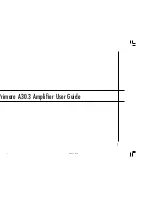
All status and level displays are concentrated in a central display area, so all important infor-
mation can be perceived at a glance.
S-DETECT
The S-DETECT LED shows when sibilants have been detected. It is only active when the
de-esser is switched on, but it is independent from the S-REDUCTION control. So if you turn
on the De-Esser, you are always informed about detected sibilants and a possible need for
regulation.
CLIP
The CLIP LED shows overload in the unit. The clipping level of the LED lies approximately 2 dB
below the internal full scale (conforms to + 19 dBu). The CLIP LED should flash as seldom as
possible.
At all relevant points of the signal flow the display gets read off: behind the preamplifier,
behind the compressor/limiter, behind the EQ and behind the output control. All possible
causes for overload can be directly checked (overdriven microphone/instrument/line gain,
an excessive make up value in the compressor/limiter, too much boost in the EQs or too high
output level).
Possible causes of overload can be quickly detected by simply switching off the modules
individually. If overloads occur during recording the quickest remedy is to gradually reduce
the respective gain control in the preamplifier.
SIGNAL
The SIGNAL LED illuminates when a signal is being received at the preamplifier. This provides
a quick method of checking that a signal source is correctly connected. All levels above -50 dB
are covered.
WARM UP
The WARM UP LED gives an indication regarding the warm up phase of the tube stage. When
the LED is extinguished the Channel One is ready for operation; during warm-up the output
signal level is low and sounds distorted.
22
Channel One
Display area
Control Elements









































